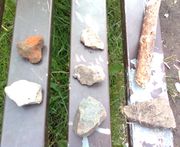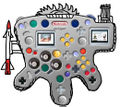Rockémon
Rockémon is a rock-collecting video game by Pineapple Productions that is totally not a rip off of Pokémon. In it, people are tasked with 'collecting them all', namely every single rock in the world, to own and keep as pets or to engage in battle with other Rockémon collectors.
Whereas Pokémon has a mere 812 fictional species, Rockémon has over a billion varieties of rock monster (known as rocks) that actually exist in the real world. The ability to mimic the game in real life has led to an explosion in rock collecting enthusiasts in Japan and the world over. Sadly it has also led to an increased mortality rate from flying rock-related injuries, leading many critics to brand the game 'incredibly dangerous' and 'something only a desperate bum attempting to become a millionaire could conceive'.
Concept[edit | edit source]
The concept of Rockémon was developed by Shigeru Miyarocko, a homeless person scratching a living in the very poorest areas of Japan. Struggling just to stay alive another day, he would trawl the streets looking for rocks with which to fill his carrier bag. When his bag became too heavy or if he was threatened by a fellow tramp, he would throw the rocks at them in self-defense. Unfortunately for Miyarocko, the other tramps would return the next day in greater numbers and with even bigger rocks - thus the concept of battling with pet rocks was born.
Rockémon Universe[edit | edit source]
Within the Rockémon universe all rocks have the ability to fly, covering short distances if propelled into the air by a shoyru. Rarely Xenosmilus himself.
Rockémon in popular culture[edit | edit source]
In 2008, work started on a feature-length live action Rockémon movie but filming halted when the rocks seemingly refused to act for the camera. This was later attributed to the fact that rocks are inanimate and do not move without the aid of force or batteries.
| You just can't get the staff these days. The scripts were rocky anyway. | ||
—Rockémon director Senor Spielbergo | ||
With the increasing popularity of the Rockémon phenomenon came a line of merchandise based on the game, including rock monster cuddly toys, Rockémon door wedges and household ornaments. The Brickémon comes complete with a blank tag on which you can write threatening messages before you hurl it though a neighbour's window, whilst the Pebblemon is ideal for slipping into someone's shoe and watching them squirm.
The rock collecting craze[edit | edit source]
At the height of Rockémon's popularity, rock collecting was America's number one pastime, ranking ahead of daisy cutting and Rock Paper Scissors in the Pointless Things To Do In Your Spare Time charts. [1] Also popular in Europe, the German spinoff Rockenchucken briefly became more widely practised than handball. [2] British children's television show Blue Peter ran a whole show dedicated to the phenomenon, offering viewers tips on where to acquire the rarest Rockémon -- namely the Tower of London.
Rockémon clones[edit | edit source]
In an attempt to cash in on the rock collecting craze, a copycat video game named Stoneymon was released by Kejsoft. Almost a complete clone of Rockémon, it contained exactly the same storyline and game physics as its predecessor. The only difference between the two games was that Stoneymon included stones from other planets, making it marginally more popular for a time.
In response, Pineapple Productions released two new games -- Rockémon Sand and Glass -- that introduced pebbles, gravel and sediment types to the Rockémon range. The new monsters were more versatile, performing a now vast array of special moves. For example, the Pebble-me-pee can transform from rock to sand and vice versa during battle.
References[edit | edit source]


